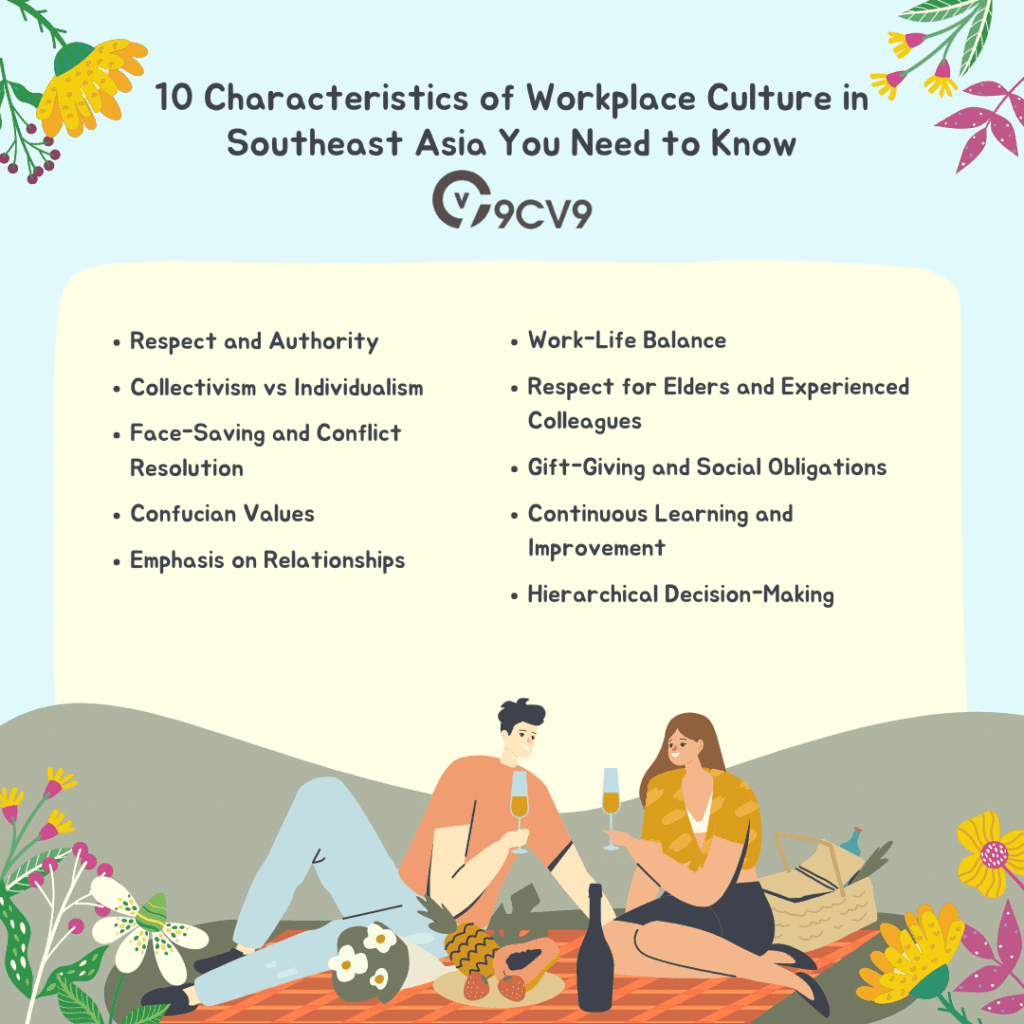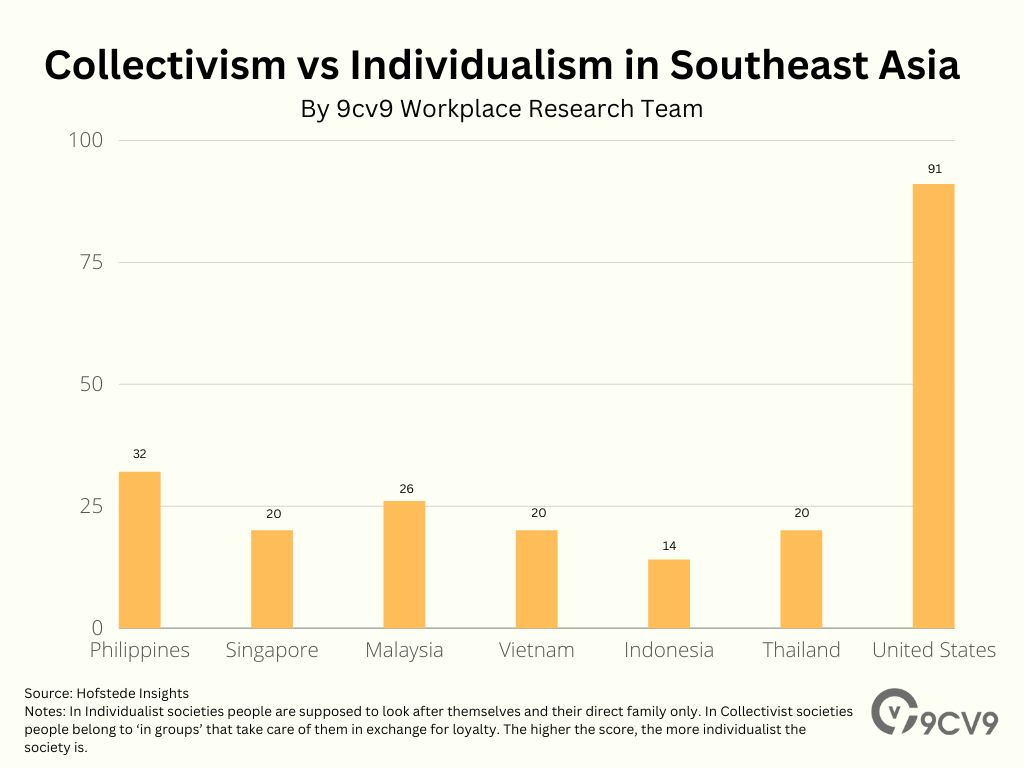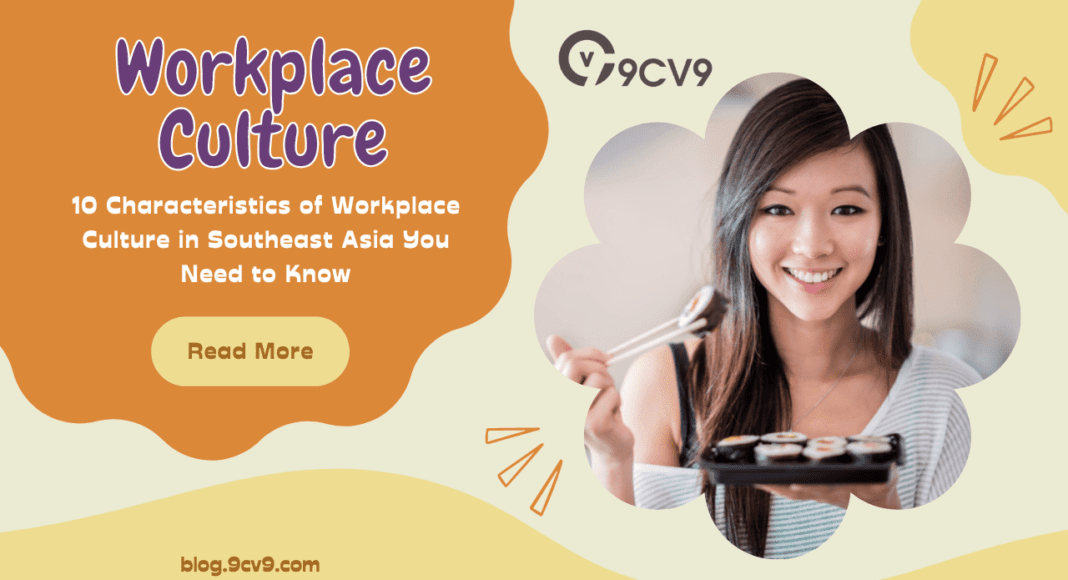Key Takeaways
- Respect for authority and hierarchy is a fundamental aspect of Southeast Asian work culture.
- Face-saving and conflict resolution are essential skills for navigating Southeast Asian workplace dynamics.
- Emphasizing relationships, striving for work-life balance, and continuous learning and improvement are key to success in Southeast Asian workplaces.
If you’re planning to work in Southeast Asia, there are a few things you should know.
For starters, the weather is hot and humid all year round, so forget about your cute little sweaters and cozy scarves.
And the food?
Well, let’s just say that Southeast Asian cuisine is not for the faint of heart.
But hey, you’re not here to talk about the weather or food, right?
You’re here to learn about the workplace culture.
And boy, do we have some things to tell you.
Southeast Asia is a region full of surprises.
It’s a place where traditions and modernity coexist, where people are friendly and hospitable, and where the concept of time is fluid.
But what about workplace culture? What can you expect when you step into an office in this part of the world?
To answer that question, we’ve compiled a list of 10 workplace culture characteristics in Southeast Asia that you need to know.
From respect for authority and hierarchy to the importance of gift-giving and social obligations, we’ll cover it all.
And don’t worry, we’ll do our best to keep it light and humorous, because let’s face it, learning about workplace culture can be a snooze-fest.
So sit back, grab a cup of coffee (or tea, if you’re feeling adventurous), and get ready to learn about the quirks and idiosyncrasies of Southeast Asian workplace culture.
Before we venture further into this article, we like to share who we are and what we do.
About 9cv9
9cv9 is a business tech startup based in Singapore and Vietnam with a strong presence all over the world.
With over six years of startup and business experience, and being highly involved in connecting with thousands of companies and startups, the 9cv9 team has listed some important learning points in this overview of the 10 characteristics of workplace culture you need to know in Southeast Asia.
If your company needs HR, hiring, or corporate services, you can use 9cv9 professional services. Book a consultation slot here, or send over an email to [email protected].
10 Characteristics of Workplace Culture in Southeast Asia You Need to Know
- Respect and Authority
- Collectivism vs Individualism
- Face-Saving and Conflict Resolution
- Confucian Values
- Emphasis on Relationships
- Work-Life Balance
- Respect for Elders and Experienced Colleagues
- Gift-Giving and Social Obligations
- Continuous Learning and Improvement
- Hierarchical Decision-Making

1. Respect and Authority
Respect for authority and hierarchy is a cornerstone of workplace culture in Southeast Asia.
In many countries in the region, such as Singapore, Malaysia, Vietnam, and Thailand, the concept of “face” is very important.
Face refers to a person’s reputation and social standing, and losing face is considered a great embarrassment.
As a result, showing respect for authority figures, such as bosses and older colleagues, is crucial in Southeast Asian workplaces.
It’s not uncommon for employees to address their bosses using formal titles or honorifics, such as “Sir” or “Madam,” and to show deference to those in positions of authority.
Hierarchy is also an important aspect of workplace culture in Southeast Asia.
In many offices, there are clearly defined levels of authority, with seniority and age playing a significant role.
Younger employees are expected to show respect to their older colleagues, and junior employees are often given specific tasks to complete by their superiors.
It’s worth noting that the emphasis on respect for authority and hierarchy can sometimes lead to a reluctance to speak up or challenge those in positions of power.
This can make it challenging for employees who are used to a more egalitarian workplace culture.
However, it’s important to remember that this cultural difference is deeply ingrained and shouldn’t be taken personally.
By showing respect and deference to those in authority, you’ll be able to build stronger relationships with your colleagues and succeed in your career in Southeast Asia.
Also, read our hiring guides and workplace tips for Southeast Asia
- Vietnam: How to hire IT Developers in Vietnam
- Malaysia: How to hire employees in Malaysia
- Thailand: How to hire and find talents in Thailand
- Philippines: How to hire and find talents in the Philippines
- Singapore: How to hire tech talents in Singapore
- Indonesia: How to hire and find talents in Indonesia
2. Collectivism vs Individualism

One of the biggest cultural differences between Southeast Asia and Western countries is the concept of collectivism versus individualism.
In Western countries, individualism is highly valued, with people encouraged to be independent and stand out.
In Southeast Asia, however, the emphasis is on collectivism or the idea that the group is more important than the individual.
As you can see from the chart above, the countries in Southeast Asia are relatively more collectivist whereas using the US as a proxy for countries in the Western sphere, we can see that the countries are more individualistic.
In Southeast Asian workplace culture, this can manifest in a number of ways.
For example, employees may be expected to work together on projects, with individual contributions valued less than the overall success of the group.
Similarly, decisions may be made based on what’s best for the team or company as a whole, rather than what’s best for individual employees.
This can be a challenging adjustment for those coming from individualistic cultures, where self-promotion and individual achievement are highly prized.
In Southeast Asia, it’s often more important to be humble and avoid drawing attention to oneself.
On the flip side, this emphasis on collectivism can lead to a strong sense of loyalty and camaraderie among colleagues.
It’s not uncommon for coworkers to socialize outside of work, and for friendships to form that extends beyond the workplace.
For example, in Vietnam, after work, there is a culture of drinking called “Nhau”. It means “Let’s go and drink and feast”. Colleagues and staff in the company will stop working and head to a nearby restaurant and drink and eat to their heart content.
Ultimately, the key to navigating this cultural difference is to strike a balance between individualism and collectivism.
While it’s important to prioritize the success of the group, it’s also important to recognize and celebrate individual contributions.
By finding a way to blend the two, you can build strong relationships with your colleagues and contribute to the success of your team or company.
3. Face-Saving and Conflict Resolution
In Southeast Asian workplace culture, the concept of face-saving is crucial.
Face-saving refers to the idea of preserving one’s reputation and avoiding embarrassment or shame.
As a result, conflict resolution in Southeast Asia often involves finding a way to save face for all parties involved.
This can manifest in a number of ways.
For example, rather than openly disagreeing with a coworker or boss, it’s common to use indirect language or gestures to communicate disagreement.
Similarly, rather than pointing out a mistake made by a colleague, it’s often more effective to frame it as a learning opportunity and provide feedback in a constructive way.
In some cases, conflict resolution may involve a third-party mediator, who can help find a solution that saves face for everyone involved.
This mediator might be someone in a position of authority, or simply a respected colleague who is able to facilitate productive communication between conflicting parties.
The emphasis on face-saving can make conflict resolution in Southeast Asia more time-consuming and nuanced than in other cultures.
However, it’s also a valuable skill to develop, as it can lead to more harmonious and productive relationships with colleagues.
Ultimately, the key to navigating this cultural difference is to be aware of the importance of face-saving and to approach conflict resolution with a willingness to compromise and find solutions that work for everyone involved.
By prioritizing the preservation of everyone’s reputation, you can build stronger relationships with your colleagues and contribute to a positive workplace culture.
4. Confucian Values
Confucianism has a strong influence on the cultures of many Southeast Asian countries, including China, Vietnam, and South Korea.

As you can see above, Southeast Asia countries are relatively more “Confucian” as compared to western countries.
As a result, Confucian values often play a significant role in workplace culture in these countries.
One of the key tenets of Confucianism is the idea of hierarchy and respect for authority.
In the workplace, this can manifest in a number of ways, including deference to bosses and senior colleagues, a focus on teamwork and collaboration, and an emphasis on maintaining harmony and avoiding conflict.
Another important Confucian value is the idea of “li,” or proper behavior.
This involves adhering to a strict set of social norms and customs, such as showing respect to elders and superiors, avoiding public displays of emotion, and maintaining a sense of humility.
Confucianism also places a high value on education and personal development.
In Singapore, the education system is highly regarded and has consistently ranked among the top in the world. In the 2018 Programme for International Student Assessment (PISA) study, Singapore ranked 1st in Mathematics and Science, and 3rd in Reading, out of 79 participating countries.
In the workplace, this can manifest in a focus on continuing education and professional development, as well as an emphasis on mentorship and guidance from more experienced colleagues.
While these values can sometimes clash with Western concepts of individualism and self-promotion, they are deeply ingrained in Southeast Asian cultures and are unlikely to change anytime soon.
By understanding and respecting these values, however, it’s possible to build strong relationships with colleagues and thrive in Southeast Asian workplaces.
Ultimately, whether you’re working in a Confucian-influenced workplace or not, the key to success is to approach your work with an open mind and a willingness to learn and adapt to different cultural norms.
By doing so, you can build strong relationships with your colleagues and contribute to a positive workplace culture.
5. Emphasis on Relationships
In Southeast Asian workplace culture, relationships are often a key priority.
This means that building and maintaining strong relationships with colleagues and clients is crucial for success.
One way this emphasis on relationships manifests is through the practice of “face time.”
This refers to the idea that spending time with colleagues and clients outside of work, such as through meals or social events, can be an important way to build rapport and strengthen relationships.
As mentioned earlier under the point of collectivism, workers in Vietnam regularly meet up after work to have “Nhau” – to feast and drink. This culture helps to build better relationships and bonding among the employees in the organization.
Another way relationships are emphasized in Southeast Asian workplace culture is through the use of “guanxi” in China or “kibei” in Japan.
These refer to the idea of using personal connections and relationships to achieve business goals, such as securing a new contract or getting a promotion.
In addition, the emphasis on relationships can also impact decision-making in the workplace.
Rather than making decisions based solely on objective criteria, factors such as personal relationships and trust may also be taken into account.
While the emphasis on relationships can sometimes be frustrating for those used to a more transactional approach to business, it can also lead to strong and lasting connections with colleagues and clients.
By taking the time to build and maintain these relationships, you can create a more positive and productive work environment.
Ultimately, the key to success in Southeast Asian workplaces is to approach relationships with a willingness to invest time and effort into building connections with colleagues and clients.
By prioritizing relationships and understanding the importance of face time and personal connections, you can build a strong network of contacts and thrive in Southeast Asian workplace culture.
6. Work-Life Balance
Work-life balance is a topic that has become increasingly important in many parts of the world in recent years.
In Southeast Asian workplace culture, however, the boundaries between work and personal life can often be more fluid.
In many Southeast Asian countries, it’s not uncommon for workdays to be long and for workweeks to extend into the weekends.
Additionally, the concept of “face time” mentioned earlier can also lead to a culture where employees feel pressure to be physically present in the office for long hours, even if their work is completed.
At the same time, however, Southeast Asian cultures also place a strong emphasis on family and personal relationships.
As a result, many workplaces may offer more flexibility when it comes to family obligations or personal time off.
Overall, the key to achieving work-life balance in Southeast Asian workplaces is often a matter of communication and negotiation.
For example, by discussing your needs and preferences with your employer and finding ways to make small adjustments, such as working from home or taking longer breaks during the day, it’s often possible to find a better balance between work and personal life.
Ultimately, while the work-life balance may look different in Southeast Asia than in other parts of the world, it’s still an important consideration for employees looking to thrive in the region’s workplace culture.
By being open to negotiation and finding ways to balance your personal and professional responsibilities, you can create a more positive and fulfilling work experience.
7. Respect for Elders and Experienced Colleagues
Respect for elders and experienced colleagues is deeply ingrained in Southeast Asian workplace culture.
This means that age and seniority often hold a significant amount of weight in decision-making and day-to-day interactions.
In many Southeast Asian countries, for example, it’s common to address colleagues who are older or more experienced with formal titles, such as “sir” or “madam.”
Additionally, younger or less experienced colleagues may be expected to defer to the opinions and decisions of their seniors, even if they have different ideas or approaches.
At the same time, however, this respect for elders and experienced colleagues can also lead to a culture of mentorship and collaboration.
Younger or less experienced colleagues may be given opportunities to learn from their more experienced counterparts, and senior colleagues may take an active interest in mentoring and guiding their junior colleagues.
Ultimately, the key to success in Southeast Asian workplaces is often a matter of finding a balance between showing respect for elders and experienced colleagues while also contributing your own ideas and perspectives.
By demonstrating a willingness to learn from others while also bringing your own unique insights to the table, you can create a more collaborative and productive work environment.
Overall, the importance of respecting elders and experienced colleagues is deeply embedded in Southeast Asian workplace culture.
By recognizing and valuing the knowledge and experience of your colleagues, you can build strong and lasting connections and succeed in this unique and vibrant workplace environment.
8. Gift-Giving and Social Obligations
Gift-giving and social obligations play an important role in Southeast Asian workplace culture.
In many Southeast Asian countries, gift-giving is viewed as a way to build and maintain relationships, and it’s not uncommon for colleagues to exchange gifts during holidays or special occasions.
However, it’s important to keep in mind that gift-giving in Southeast Asia is often accompanied by a set of social expectations and obligations.
For example, if a colleague gives you a gift, it’s generally expected that you will reciprocate with a gift of similar value or significance.
Additionally, social obligations such as attending events or participating in cultural customs can also be an important part of Southeast Asian workplace culture.
For example, it’s not uncommon for colleagues to invite each other to attend weddings, funerals, or other important events.
While these social obligations can be a bit overwhelming for those who are not used to them, they can also be an opportunity to build stronger connections with your colleagues and gain a deeper appreciation for the local culture.
Overall, while gift-giving and social obligations may be unfamiliar to those from other parts of the world, they are an important part of Southeast Asian workplace culture.
By being open to participating in these customs and by showing appreciation for your colleagues through small gestures such as gift-giving, you can build stronger relationships and succeed in this unique and vibrant work environment.
9. Continuous Learning and Improvement
Continuous learning and improvement are highly valued in Southeast Asian workplace culture.
In many Southeast Asian countries, education is viewed as a key pathway to success, and many employers prioritize professional development and training for their employees.
As a result, it’s not uncommon for Southeast Asian professionals to pursue ongoing education and training opportunities throughout their careers.
This commitment to learning can be seen in a variety of different contexts, from attending conferences and workshops to pursuing advanced degrees or certifications.
At the same time, this emphasis on continuous learning and improvement also means that Southeast Asian workplaces tend to be highly competitive.
Colleagues may push each other to constantly improve and innovate, and there may be a strong focus on achieving measurable results and demonstrating one’s expertise.
Ultimately, this commitment to continuous learning and improvement can be a powerful driver of success in Southeast Asian workplaces.
By staying up-to-date with the latest industry trends and innovations, and by constantly striving to improve one’s skills and knowledge, professionals can position themselves for long-term success and growth.
Overall, if you’re working in a Southeast Asian workplace, it’s important to recognize the value placed on continuous learning and improvement.
By staying open to new opportunities for growth and development, and by embracing a mindset of lifelong learning, you can thrive in this dynamic and challenging work environment.
10. Hierarchical Decision-Making
In many Southeast Asian countries, there is a deep respect for authority and hierarchy, which often translates into a top-down approach to decision-making.
This means that decisions are typically made by senior management or those in positions of authority, and lower-level employees are expected to follow those decisions without question.
This can be a challenging aspect of Southeast Asian workplace culture for those who are used to more egalitarian decision-making processes, where input and feedback from all team members are valued and considered.
In these cultures, decision-making is often a collaborative effort that involves discussion and debate among team members, with the goal of arriving at a consensus.
However, in Southeast Asia, decisions are often made by those in positions of power without seeking input from lower-level employees.
This can lead to a sense of frustration and disempowerment among team members, who may feel that their opinions and expertise are not valued.
It’s important to understand and respect this cultural practice in order to navigate the workplace effectively and build strong working relationships with colleagues and superiors.
If you are working in Southeast Asia, it’s important to be aware of the power dynamics within your organization and to recognize that decisions may be made by those in positions of authority without seeking input from lower-level employees.
At the same time, it’s important to be proactive in building relationships with colleagues and superiors and to look for opportunities to provide input and feedback when appropriate.
By doing so, you can demonstrate your value as a team member and build a more collaborative and effective work environment.
Conclusion
Well, there you have it folks, 10 essential characteristics of workplace culture in Southeast Asia that you need to know.
From respect for authority and hierarchy to face-saving and conflict resolution, and from Confucian values to gift-giving and social obligations, it’s clear that Southeast Asian workplace culture is unique, dynamic, and often quite different from what you may be used to.
But don’t worry, with a little bit of understanding, an open mind, and a willingness to learn and grow, you can succeed and thrive in this exciting and challenging work environment.
So, whether you’re a seasoned professional or a newbie just starting out, keep these 10 characteristics in mind as you navigate the world of Southeast Asian work culture.
Embrace the emphasis on relationships, strive for work-life balance, respect your elders, and don’t forget to enjoy the amazing food and hospitality that Southeast Asia has to offer.
Remember, Southeast Asian workplace culture may be different, but it’s also full of opportunity and potential for growth.
So, go ahead and dive in, embrace the unique characteristics of this vibrant culture, and get ready for an amazing journey of learning, growth, and success.
If your company needs HR, hiring, or corporate services to hire talents in Southeast Asia, you can use 9cv9 hiring services. Book a consultation slot here, or send over an email to [email protected].
If you find this article useful, why not share it with your startup and business friends and also leave a nice comment below?
We, at the 9cv9 Research Team, strive to bring the latest and most meaningful data, guides, and statistics to your doorstep.
Also, read our hiring guides and workplace tips for Southeast Asia
- Vietnam: How to hire IT Developers in Vietnam
- Malaysia: How to hire employees in Malaysia
- Thailand: How to hire and find talents in Thailand
- Philippines: How to hire and find talents in the Philippines
- Singapore: How to hire tech talents in Singapore
- Indonesia: How to hire and find talents in Indonesia































![Writing A Good CV [6 Tips To Improve Your CV] 6 Tips To Improve Your CV](https://blog.9cv9.com/wp-content/uploads/2020/06/2020-06-02-2-100x70.png)


